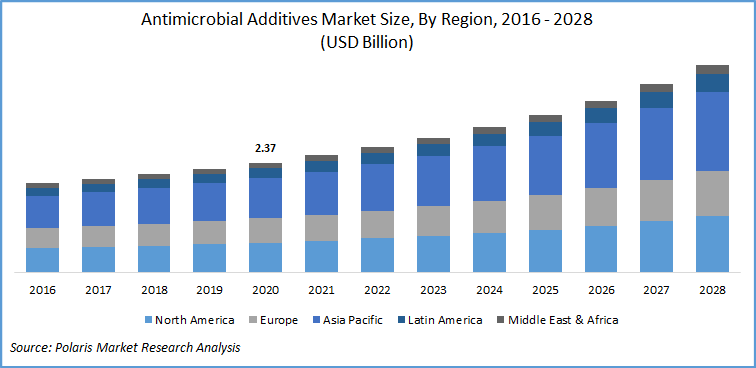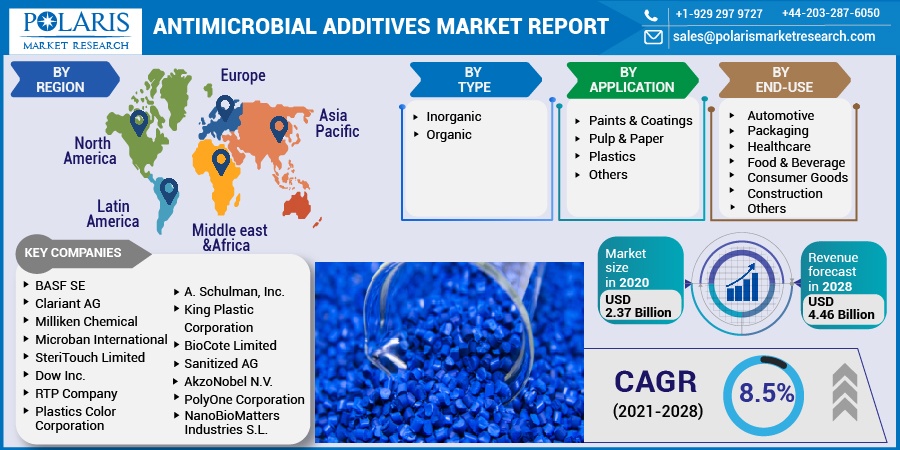
Antimicrobial Additives Market Share, Size, Trends, Industry Analysis Report, By Type (Inorganic, Organic); By Application (Paints & Coatings, Pulp & Paper, Plastics); By End-Use (Automotive, Packaging, Healthcare, Consumer Goods, Construction, Food & Beverage); By Regions; Segment Forecast, 2021 - 2028
- Published Date:Mar-2021
- Pages: 111
- Format: PDF
- Report ID: PM1260
- Base Year: 2020
- Historical Data: 2016 - 2019
Report Outlook
The global antimicrobial additives market size was valued at USD 2.37 billion in 2020 and is expected to grow at a CAGR of 8.5% during the forecast period. Antimicrobial Additives are used in varied applications such as construction, packaging, automotive, and food and beverage among others.
Antimicrobial Additives are capable of inhibiting the growth of microorganisms on a surface, thereby improving performance and durability. Antimicrobial additives such as silver and zinc are added during the manufacturing process of products.
Silver is widely used in these products owing to its broad-spectrum performance and use in diverse materials and applications. Silver is highly effective against microbial market growth while reducing cross-contamination, increasing functional lifetime, and improving durability. Some applications of silver-based types include textile, bed rails, and water tanks, among others.
Zinc-based additives are broad-spectrum antimicrobials acting against bacteria, fungi, mold, mildew, and algae. The zinc-based antimicrobial is used in varied applications such as paints, textiles, and polymer products owing to features such as high chemical stability, high sturdiness, and long life.

Know more about this report: request for sample pages
Industry Dynamics
Growth Drivers
The market demand for the product has increased significantly for food packaging applications. Packaging solutions with antimicrobial additives provide functional barriers from the external environment and the growth of microbes to prevent deterioration of food during processing, packaging, shipping, storage, and distribution. Zinc-based types are selective toward a wide range of Gram-positive and gram-negative bacteria.
The increasing need for food preservation, quality maintenance, and safety has increased the adoption of the product. Antimicrobial packaging solutions are aimed at addressing food safety concerns and stringent regulations to prevent food-borne infectious diseases while improving food quality and extending the shelf life of food products.
The global market for antimicrobial additives is fueled by the economic growth in countries such as China, Japan, and India, rising industrialization, and growing demand from industries such as automotive, food and beverage, and textiles. Global players are expanding into developing countries to tap market potential provided by automotive and construction sectors, further boosting the market growth.
Technological advancements, new product launches, and acquisitions by leading players in the market coupled with increasing use in paints & coatings have increased the demand for antimicrobial additives across the globe. Growing disposable income, changing lifestyles, and increasing health awareness would provide market growth opportunities during the forecast period.

Know more about this report: Request for sample pages
Antimicrobial Additives Market Report Scope
The market is primarily segmented on the basis of type, application, end-use, and region.
|
By Type |
By Application |
By End-Use |
By Region |
|
|
|
|
Know more about this report: request for sample pages
Type Outlook
The type market segment has been divided into is inorganic additives and organic additives. The demand for inorganic antimicrobial additives is expected to increase during the forecast period. Inorganic antimicrobial additives include zinc, copper, and silver, among others. Silver provides excellent antimicrobial efficacy and robust physical properties, increasing its application in paints, coatings, textiles, and medical equipment. The addition of copper and zinc also provides antimicrobial protection, and are used in industries such as healthcare, construction, and packaging, among others.
Application Outlook
The application market segment has been divided into paints & coatings, pulp & paper, plastics, and others. The plastics segment accounted for a major market share in 2019. Antimicrobial additives are added in different types of plastics and polymers such as polyethylene, acrylonitrile butadiene styrene, polypropylene, and polycarbonate during manufacturing for lasting protection against microbes.
An additive can be in different forms such as concentrated powder, liquid suspension, or masterbatch pellet on the basis of product requirements. The addition of antimicrobial additives to plastics offers benefits such as protection against harmful bacteria, mold, fungi, and viruses, thereby reducing the chances of staining, bad odors, and material degradation.
End-Use Outlook
On the basis of end-use, the market is segmented into automotive, packaging, healthcare, food & beverage, consumer goods, construction, and others. The healthcare segment dominated the global market for antimicrobial additives in 2020. The high traffic environment in healthcare facilities coupled with the increasing need to maintain hygiene and patient safety necessitates the use of antimicrobial additives.
Integration of antimicrobial additives in products such as breathing circuits, mobile carts, endoscopes, surgical drapes, beds, patient transport equipment, shelving units, dental trays, healthcare textiles, and furniture & seating offer effective protection against antibiotic-resistant bacteria and caters to the stringent hygiene principles in the industry.
Geographic Overview
Asia Pacific is expected to exhibit significant growth during the forecast period. Increasing urbanization, growing automotive industry, expansion of international players in this region, and technological advancements are some factors attributed to the growth of this regional segment. Increasing application of antimicrobial additives in the construction sector and significant investments in the construction of energy-efficient and sustainable buildings in countries of this region is driving the antimicrobial additives market growth. The industrial growth in countries such as China, India, and Japan, rising automotive penetration, increasing use in the healthcare sector, and rising applications in packaging have further increased the demand for antimicrobial additives in Asia Pacific.
Competitive Landscape
The leading players in the antimicrobial additives market include BASF SE, Clariant AG, Momentive Performance Materials Inc., Milliken Chemical, Microban International, SteriTouch Limited, Dow Inc., Plastics Color Corporation, RTP Company, LyondellBasell Industries Holdings B.V., A. Schulman, Inc., King Plastic Corporation, BioCote Limited, Sanitized AG, AkzoNobel N.V., Life Materials Technologies Limited, NanoBioMatters Industries S.L., and PolyOne Corporation.
These players are expanding their presence across various geographies and entering new markets in developing regions to expand their customer base and strengthen their presence in the market. The companies are also introducing new innovative products in the market to cater to the growing consumer demands.

